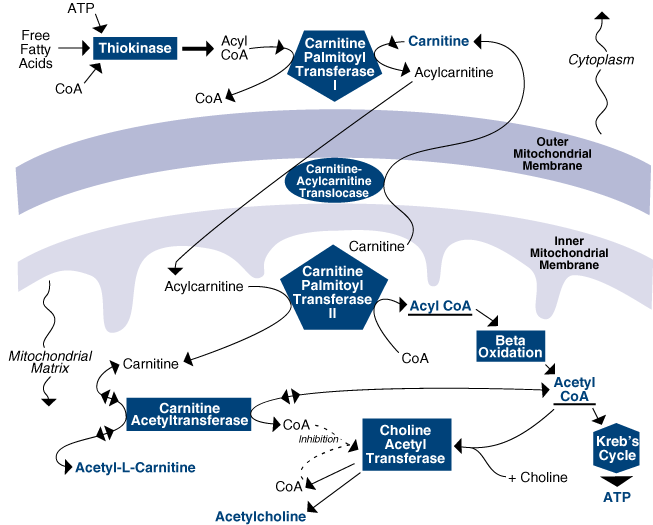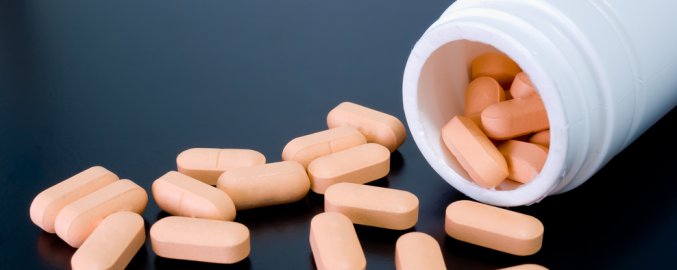Acetyl-L-Carnitine: Metabolism and Applications in Clinical Practice
John H. Furlong N.D.
--------------------------------------------------------------------------------
Abstract
Recent research has clarified many of the clinical applications of L-Carnitine and its related compounds, leading into new areas of potential use. Promising therapeutic applications of an ester form of carnitine, acetyl-L-Carnitine (ALC) are derived from observations that this compound readily crosses the blood- brain barrier and improves neuronal energetics and repair mechanisms while modifying acetylcholine production in the CNS. Studies show that HIV infection and CFIDS, AlzheimerÍs dementia and depression of the elderly, and diabetic neuropathies may respond positively to ALC administration. Effects of ALC on ethyl alcohol (ETOH) metabolism have been observed and hold significant potential in preventing sequelae of habitual ETOH abuse. (Alt Med Rev 1996;1(2):85-93)
--------------------------------------------------------------------------------
Synthesis and Function
L-Carnitine is synthesized in mammalian liver, kidney and brain tissue with lysine, methionine and vitamin C among the required substrates and co-factors. The main body stores are in skeletal and cardiac muscle. Acetyl-L-Carnitine is one of the esters of carnitine and is found along with free plasma carnitine and other acyl esters of varying chain length.1
The formation of ALC originates with cytoplasmic thiokinase (See Figure 1) which forms acylcoenzyme A from free-fatty acids, ATP and Coenzyme A (CoA). This substance is combined with carnitine to form acylcarnitine via carnitine palmitoyltransferase I. Entry into the mitochondrial matrix occurs through an exchange system of acylcarnitine/carnitine via carnitine-acylcarnitine translocase. For each acylcarnitine molecule traversing the inner mitochondrial membrane, a molecule of carnitine is shuttled out. On the inner mitochondrial membrane, carnitine palmitoyltransferase II converts acylcarnitine to carnitine, liberating acylCoA. Finally, the production of ALC and CoA from carnitine and acetylCoA (obtained via ß oxidation of acyl CoA) occurs via carnitine acetyltransferase present in the mitochondrial matrix.2
Carnitine and its esters prevent toxic accumulations of fatty acids and acyl CoA (in the cytoplasm and mitochondria, respectively) while providing acetyl CoA for energy generation in the mitochondria. ALCÍs enzymatic formation in the mitochondrial matrix is reversible, providing free Coenzyme A and acetyl CoA which can readily be exchanged across membranes, thus providing metabolic energy to intracellular organelles.3 Carnitine acetyltransferase is a reversible enzyme system which appears to be linked with choline acetyltransferase (ChAT), thereby supplying intracellular acetylcholine while the opposite reaction liberates acetylCoA.
Figure 1
--------------------------------------------------------------------------------
This mechanism can explain the improved cholinergic neurotransmission and enhanced intracellular energetics observed in ALC research.4, 5 Studies in humans and guinea pigs have shown that supplemental choline is able to decrease the urinary excretion of carnitine while resulting in increased muscle carnitine stores, giving further evidence of this enzymatic linkage.6
HIV, CFS and Immunomodulation
HIV infection presents numerous problems related to the carnitines. Human and animal studies show an increased urinary excretion of carnitine when pivampicillin is administered. Animal studies indicate that pivampicillin interferes with myocardial carnitine metabolism subsequent to pivalocarnitine formation in the heart, leading to increased excretion. AZT can result in muscle carnitine depletion, contributing to the lipid accumulation and mitochondrial dysfunction characteristic of this myopathy. Malabsorption may decrease carnitine availability at the cellular level, while HIV-related renal dysfunction may increase excretion of the compound. Thus it is postulated that a subgroup of HIV-infected individuals are burdened with secondary carnitine deficiencies.7-9
ALC and L-CarnitineÍs effect on leukocyte proliferation and production of tumor necrosis factor-a (TNF-a) provide new potential applications of the compounds in HIV-infected individuals. Both mitogenic and antigenic proliferation of lymphocytes have been increased with LC and ALC in vitro.7
Peripheral blood monocytes in AIDS patients are low in intracellular carnitine. Serum levels may be high, low or normal and is therefore unreliable as an indicator of carnitine metabolism.10,11 Peripheral blood monocytes from HIV-infected individuals were cultured with the mitogen PHA and ALC for 48 hours. PHA-induced proliferation was significantly improved and a dimunition of TNF-a released by the cultured monocytes was also observed to be significant. As TNF-a has a key role in HIV-mediated apoptotic cell destruction, decreased levels of this cytokine may have protective effects on CD4+ cell populations.12
In a brief clinical trial with AIDS patients, L-Carnitine was administered (6 g/day for 14 days) and lymphocyte proliferation improved in response to mitogen stimulation. Importantly, the increased monocyte production did not lead to increased HIV proliferation. TNF-a levels were decreased and ß-2 microglobulin, an indicator of HIV progression to AIDS was also diminished.13,14 Thus, LC and ALC represent novel approaches in complementary treatment of HIV infections and may correct secondary carnitine deficiencies found in these patients.
Another potential application of ALC involving immunomodulation is in the management of Chronic Fatigue Syndrome (CFS). Low serum levels of ALC have been observed in many CFS patients. The clinical presentation of marked fatigue correlates with periods of low serum ALC while periods of recovery are characterized by higher levels of ALC. 15 Further implications for ALC treatment of CFS patients are findings that plasma levels of ß-endorphin and cortisol are raised in humans given an I.V. bolus of ALC.16 As abnormal cortisol levels have been observed in some patients with CFS, and the myalgic symptoms in this condition are well known, ALC administration might be particularly helpful in normalizing HPA perturbations via feedback mechanisms and decreasing myalgic pain via peripheral neuron response to ß-endorphin.17
AlzheimerÍs Dementia/CNS Effects
Research has examined the effects of ALC in various dementias, cognitive defects and age-related disorders. These observations represent the clearest understanding and application of ALC in clinical practice. It has been established that ALC traverses the blood-brain barrier efficiently, with CSF concentrations increasing significantly via both an I.V. and oral route in patients with severe dementia.18 There are multiple mechanisms of action responsible for ALC-induced CNS changes: enhanced cholinergic neurotransmission, neuronotrophic effects (via binding of cortisol and increased nerve growth factor production in the hippocampus),muscarinic receptor changes as well as decreased free radical generation and lipofuscin deposits in animal models.18,19
Calvani, et al summarized the neuroprotective benefits of ALC in the hippocampus, prefrontal cortex, substantia nigra and muscarinic receptor portions of the brain. These included antioxidant activity, improved mitochondrial energetics, stabilization of intracellular membranes and cholinergic neurotransmission. In the 500+ patients with AlzheimerÍs or other age-related dementias presented in this review, it was concluded that oral ALC administration may slow the progression of degeneration. The dose of ALC varied from 1.5 grams/day to 3.0 grams/day. Patient tolerance was excellent with no clinically significant differences in side effects between the treatment and placebo groups. 20
Patients with AlzheimerÍs dementia showed improvement in both clinical and CNS measurements in one double-blind placebo controlled trial over a 1-year period. Although this was a small study (7 patients in the treatment group), the findings were significant in elucidating the protective/reparative effects of ALC on the neuronal membranes.21 Another study showed significant improvements in all cognitive, behavioral and emotive measurements except anxiety in a 40-day double-blind, placebo-controlled study of 40 patients with AlzheimerÍs. This work was particularly helpful in outlining clinical methods of patient assessment which may be applicable in the out-patient setting. 22
A study of 6 months duration on an out-patient basis showed mild improvements in tasks of attention and timing. Memory facilitation was improved only in the more impaired subset of the treatment group. This subset also showed a significant increase of ALC levels in the CSF. 23 MartignoniÍs study showing increased ß-endorphin production in response to ALC administration presents yet another potential benefit of ALC in the patient with AlzheimerÍs dementia because of their tendancy to have reduced ß-endorphin levels.
Some positive results in the above studies may be due to enhanced memory trace formation, a key issue in cognitive research. Animal models indicate that protein kinase C translocation from the cytosol (soluble form) to the neuronal membrane (particulate form) of the hippocampus and cortex may serve as a marker for memory formation. ALC is able to increase particulate protein kinase C in rat cortex at a dose (60mg/kg) that also elicits improvements in learning, providing evidence of ALCÍs participation in memory formation via neuronal membrane modification. This effect was lost after long incubation times or higher concentrations of ALC, suggesting multiple control mechanisms for the protein kinase C.24
Depression/Cortisol Levels
The effects of ALC on cortisol levels have been varied. In one 40-day study of depressed elderly adults, significant normalization of elevated cortisol levels and improved scores on mood assessments resulted from ALC administration (0.5g/qid p.o.). In 43% of the patients, the treatment was so successful that they were determined to be in clinical remission.25 This supports an earlier study of 24 depressed adults treated over a 2-month period where the depressive symptoms improved to a high degree of significance, especially in the group with the most severe clinical presentation.26 However, in the study by Martignoni, with non-depressed healthy male volunteers, the intravenous administration of ALC raised cortisol levels along with ß-endorphin. It appears that ALC may have an amphoteric effect on cortisol levels, raising or lowering levels according to HPA feedback mechanisms.
Diabetes/Neurological Symptoms
Peripheral neuropathy associated with diabetes mellitus (DM) is extremely common, approaching over 28% of some populations.27 Various mechanisms of neuronal damage have been postulated, including polyol pathway generation of sorbitol and free radical damage. Reduced nerve conduction velocities occur in DM and have led to experimental models assessing this function in rats. Animals given ALC after experimental diabetes induction have improved nerve conduction velocities.28,29 Correction of abnormal enteric peptides associated with autonomic neuropathies was also observed in animal models. 30
Human studies also show beneficial effects of ALC in neuropathies. Intramuscular administration of the compound given to 63 patients with painful neuropathy for 15 days showed significant improvement in motility and subjective measures.31 A small double-blind study in humans again using the I.M. route of administration, showed highly significant improvement in painful neuropathies. Again the anti-oxidant function of ALC was believed to be a likely mechanism of action.32
Aging and Repair of Neuronal Tissue
The changes which occur in CNS tissue of aged laboratory animals as well as tissue samples from humans have both structural and metabolic components. One of these changes is the reduced surface contact area found in dendritic networks. The capacity for recovery and expansion of the dendritic network does, however, remain present in older individuals.33 ALC was administered orally to rats over a 6-22 month period after which brain synaptic tissue was evaluated for size and number of junctions. The expected decline in synaptic contact area was partially reversed in the treatment groups.34
Human studies confirm the impact ALC can have on neurological function. Bonavita observed significant improvements in aged subjects participating in a 40-day, double-blind trial with oral ALC, 3 g/day. The first changes tended to relate to spatial recognition, judgment and depression; second-phase changes centered on short and long-term memory, self-care, and sociability. Intravenous administration of ALC elicited increased visual evoked potential amplitude among both healthy volunteers and patients with various dementias. The changes persisted over a 50-90 minute period, showing the rapid clearing of the substance by renal tubular mechanisms. 35
Repair of tissue atrophy after neuronal damage is a function of the length of denervation time and rate of regeneration of neuronal tissue. In a comparison study of the nerve-regeneration effects of L-Carnitine and ALC, there were significant improvements in the ALC group of animals compared to the L-Carnitine group. This was postulated to be related to ALCÍs unique ability to supply acetyl groups for mitochondrial energy production.36
Clinical applications of the neuro-regenerative effects of ALC were investigated in an experimental model of post-ischemic cerebral injury. In a simulation of the cerebral ischemia present after cardiac arrest, ALC was administered intravenously to canines. Their recovery was assessed via neurologic deficit scores and neurochemical markers. The ALC group fared significantly better than controls in post-ischemic recovery parameters. 37
Cardiovascular Effects
Acetyl-L-Carnitine is a substance which retains the well-known effects of L-Carnitine on muscle tissue; i.e., long-chain fatty acid transport for ATP production within the mitochondria. ALCÍs further impact on both skeletal muscle and the myocardium include antioxidant effects leading to less lipid peroxidation, thus protecting exercising muscle tissue from free-radical damage.38 Additionally, it may improve cardiolipin levels in the aged heart, a substance which maintains crucial membrane factors in cardiac mitochondria and thus ensures efficient phosphate transport for energy. In a rat mitochondrial model, it was shown that ALC administered to aged animals returned cardiolipin levels to that of young ones. 39
Cerebral and peripheral circulation are apparently affected differently by administration of ALC. Ten patients with recent cerebral vascular accidents were given ALC intravenously which resulted in acute enhancement of cerebral blood flow to areas of ischemia via sensitive SPEC tomography assessments.40 In evaluation of patients with peripheral arterial occlusive disease, two studies show that the effect of carnitine esters on improved walking distance was due to metabolic vs. hemodynamic changes and that L-Propionylcarnitine was clearly superior to L-Carnitine in this effect. These studies demonstrate the ability of carnitine esters to positively influence tissue energetics which may prove beneficial in a chronic administration model.41,42
Acetyl-L-Carnitine and Ethanol
A number of interesting reports on the relationship between hepatic detoxification of ethanol and carnitines have been produced. It is observed that pretreatment of both rats and chickens with carnitines resulted in a prolonged half-life of ethanol in the blood.43,44 Additionally, a protective effect on prenatal ethanol damage to thalamic and cortical regions in rats was observed with administration of ALC.47 Two studies by Cha and Sachan with isolated rat hepatocytes harvested after pretreatment with ALC elucidate the mechanism of these interesting effects. An inhibition of alcohol dehydrogenase was present and significantly increased when the nicotinamide adenine dinucleotide:ALC ratio was low. It was also shown that L-Carnitine itself was much less effective at producing this inhibition.47,48 As a final addition to these findings of great therapeutic interest, oral administration of ALC was shown to improve the cognitive impairments of 55 chronic alcoholics.48
We may infer from this work that patients with high ethanol intake may have prolonged ethanol half-life if they are concurrently taking ALC supplementation. This effect may be due in part to low niacin levels and could be modified by niacin administration. ALCÍs cerebro-thalamic protection observed in rat pups exposed to ethanol prenatally and the apparent hepato-protective effects observed in models of chronic alcohol use provide exciting possibilities for preventing the intergenerational sequelae of high ethanol intake.
Adverse Effects/Interactions
In 130 patients studied by Spagnoli, et al over a one-year duration, the administration of oral ALC (2 grams/day) slowed the progression of AlzheimerÍs disease. Patients in the treatment group experienced significant positive effects, ascertained by neuropsychological tests, in a variety of areas. At the 3-month mark, agitation was experienced by 11% of patients taking ALC and 6% of patients taking placebo, a difference which was not statistically significant. The incidence of agitation in both groups decreased to 7% by the 6-month follow-up.49 Adverse reactions occurred in a small study of 36 patients with AlzheimerÍs dementia. Eight of the 11 withdrawals from the active group reported nausea/vomiting or agitation/aggression within the first 14 days of the trial. No laboratory abnormalities were noted in the study. It was suggested that administration of the ALC follow a meal to minimize symptoms.50
In addition to the minor adverse reactions to ALC from the above human trials, a cautionary note may be extrapolated from rat studies whereby an intracerebral injection of ALC induced epileptic phenomena.51 Another researcher found however, no changes in cell excitability and no epileptic discharges in ALC- treated rats exposed to high-frequency stimulation.19 From the clinical and experimental research, it seems prudent to:
Administer ALC with food;
Inform patients that ALC may modify ETOH tolerance;
Inform patients/families of potential agitation, nausea or vomiting; and
Screen for epileptic history if ALC is to be used I.V.
Conclusions
As ALC is easily transported across the blood-brain barrier, multiple benefits in CNS function have been observed in human studies. Models of aging, stroke, AlzheimerÍs dementia, diabetic neuropathy and neuropeptide release have been positively influenced by ALC administration. Acetyl-L-Carnitine is able to exert profound effects on some depressed patients with high cortisol levels and participates in immunomodulatory mechanisms which hold promise in the treatment of HIV infection. ALC modifies ethanol metabolism in animal models; paradoxically increasing the half-life of ethanol while decreasing hepatic damage.
Because of ALCÍs excellent tolerability, with infrequent and often temporary side effects, it has great potential of being a safe and efficacious therapeutic compound. Oral doses from 1.5 grams to 3.0 grams per day are typically in the therapeutic range for most conditions, the I.M. route was used for treatment of neuropathy. Although many of ALCÍs effects overlap those of L-Carnitine, the vast experience with the simpler compound in ischemic heart disease should not be abandoned. For conditions regarding CNS and neuronal damage, the L-Acetyl form of carnitine is clearly superior. With additional research and clinical trials, future applications of ALC hold exciting promise in the practice of complementary medicine.
References
1. Goa KL, Brogden A. L-Carnitine, a preliminary review of its pharmacokinetics, and its therapeutic use in ischaemic cardiac disease and primary and secondary carnitine deficiencies in relationship to its role in fatty acid metabolism. Drugs 1987;34:1-24.
2. HarperÍs Review of Biochemistry, 23rd Ed. R.K. Murray,D.K. Granner, P.A. Mayes and V.W. Rodwell; Eds. Appleton-Lange Medical Publications pp 220-223.
3. Calvani M, Carta A. Clues to the mechanism of action of acetyl-L-carnitine in the central nervous system. Dementia 1991;2:1-6.
4. White HL, Scates PW. Acetyl l-carnitine as a precursor of acetylcholine. Neurochem Res 1990;15:597-601.
5. Piovesan P, Quatrini G, Pacifici L, et al. Acetyl-l- carnitine restores choline acetyltransferase activity in the hippocampus of rats with partial unilateral fimbria-fornix transection. Int J Devl Neuroscience 1995;13:13-19.
6. Daily JW, Sachan DS. Choline supplementation alters carnitine homeostasis in humans and guinea pigs. J Nutr 1995;125:1938-1944.
7. Famularo G, Tzantzoglou S, Santini G, et al. L-carnitine - a partner between immune response and lipid metabolism. Mediators Inflamm 1993;2: s29-s32.
8. Diep QN, Brors O, Bohmer T. Formation of pivaloylcarnitine in isolated rat heart cells. Biochem Biophys Acta 1995;1259:161-165.
9. Mintz M. Carnitine in human immunodeficiency virus type I infection / acquired immune deficiency syndrome. J Child Neurol 1995;10:s40-s44.
10. DeSimone C, Tzantzglou S, Jirillo E, et al. L-carnitine deficiency in AIDS patients. AIDS 1992;6:203-205.
11. DeSimone C, Famularo G, Tzantzoglou S, et al. Carnitine depletion in peripheral blood mononuclear cells from patients with AIDS: effect of oral L-carnitine. AIDS 1994; 8:655-660.
12. Famularo G, DeSimone C. Apoptosis, anti-apoptotic compounds and TNF-a release. Immunol Today 1994;5:495-496.
13. Famularo G, DeSimone C. A new era for carnitine? Imunol Today 1995; 16:211-213.
14. DeSimone C, Tzantzoglou S, Famularo G, et al. High dose L-carnitine improves immunologic and metabolic parameters in AIDS patients. Immunopharmacol Immunotoxicol 1993;15:1-12.
15. Kuratsune H, Yamaguti K, Takahashi M, et al. Acylcarnitine deficiency in chronic fatigue syndrome. Clin Infect Dis 1994:18; s62-s67.
16. Martignoni E, Facchinetti F, Sances G, et al. Acetyl-L-carnitine acutely administered raises ß-endorphin and cortisol plasma levels in humans. Clin Neuropharmacol 1988;11:472-477.
17. Blalock JE. The syntax of immune-neuroendocrine communication. Immunol Today 1994;15:504-511.
18. Parnetti L, Gaiti A, Mecocci P, et al. Pharmacokinetics of IV and oral acetyl-L-carnitine in a multiple dose regimen in patients with senile dementia of Alzheimer type. Eur J Clin Pharmacol 1992;42:89-93.
19. Davis S, Markowska AL, Wenk GL, et al. Acetyl-L-carnitine: behavioral, electrophysiological, and neurochemical effects. Neurobiol Aging 1993;14:107-115.
20. Calvani M, Carta A, Caruso G, et al. Action of acetyl-l-carnitine in neurodegeneration and AlzheimerÍs disease. Ann NY Acad Sci 1992;663:483-486.
21. Pettigrew JW, Klunk WE, et al. Clinical and neurochemical effects of acetyl-l-carnitine in AlzheimerÍs disease. Neurobiol of Aging: 1995;16:1-4.
22. Bonavita E. Study of the efficacy and tolerability of L-acetylcarnitine therapy in the senile brain. Int J Clin Pharmacol Ther Tox 1986;24:511-516.
23. Sano M, Bell K, Cote L, et al. Double-blind parallel design pilot study of acetyl levocarnitine in patients with alzheimerÍs disease. Arch Neurol 1992; 49:1137-1141.
24. Pascale A, Milano S, Corsico N, et al. Protein kinase C activation and anti-amnesic effect of acetyl-L-carnitine:in vitro and in vivo studies. Eur J Pharmacol 1994;265:1-7.
25. Gecele M, Francesetti G, Meluzzi A. Acetyl-Lcarnitine in aged subjects with major depression: clinical efficacy and effects on the circadian rhythm of cortisol. Dementia 1991;2:333-337.
26. Tempesta E, Casella L, Pirrongelli C, et al. L-acetylcarnitine in depressed elderly subjects. A cross-over study vs. Placebo. Drugs Exp Clin Res 1987; 13:417-423.
27. Young MJ, Boulton AJM, Macleod AF, et al. A multicentre study of the prevalence of diabetic peripheral neuropathy in the United Kingdom hospital clinic population. Diabetalogica 1993;36:150-154.
28. Lowitt S, Malone JI, Salem AF, et al. Acetyl-L-carnitine corrects the altered peripheral nerve function of experimental diabetes. Metabolism 1995; 44:677-680.
29. Merry AC, Kamijo M, Lattimer S, et al. Long-term prevention and intervention effects of acetyl-L-carnitine on diabetic neuropathy in BB/W-rats. Diabetes 1994;43:108A.
30. Gorio A, DiGiulo AM, Tenconi B, et al. Peptide alterations in autonomic diabetic neuropathy prevented by acetylcarnitine. Int J Clin Pharm Res 1992;12:225-230.
31. Onofrj M, Fulgente T, Melchionda D, et al. L-acetylcarnitine as a new therapeutic approach for peripheral neuropathies with pain. Int J Clin Pharm Res 1995;15:9-15.
32. Quatraro A, Roca P, Donzella C, et al. Acetyl-l-carnitine for symptomatic diabetic neuropathy. Diabetalogica 1995;38:123.
33. Bertoni-Freddari C, Fattoretti P, Casoli T, et al. Morphological adaptive response of the synaptic junctional zones in the human dentate gyrus during aging and alzheimerÍs disease. Brain Res 1990;517:69-75.
34. Bertoni-Freddari C, Fattoretti, P, Casoli T, et al. Dynamic morphology of the synaptic junctional areas during aging: the effect of chronic acetyl-L-carnitine administration. Brain Res 1994;656:359-366.
35. Gambi D, Onofrj M, Calvani M, et al. Neurophysiological studies of L-acetylcarnitine administration in man. Drugs Exp Clin Res 1989;15:435-446.
36. Fernandez E, Pallini R, Gangitano C, et al. Effects of L-carnitine, L-acetylcarnitine and gangliosides on the regeneration of the transected sciatic nerve in rats. Neurological Res 1989;11:57-62.
37. Rosenthal RE, Williams R, Yolanda BA, et al. Prevention of postischemic canine neurological injury through potentiation of brain energy metabolism by acetyl-L-carnitine. Stroke 1992;23:1312-1318.
38. DiGiacomo C, Latteri F, Fichera C, et al. Effect of acetyl-L-carnitine on lipid peroxidation and xanthine oxidase activity in rat skeletal muscle. Neurochem Res 1993;18:1157-1162.
39. Paradies G, Ruggiero FM, Gadaleta MN, et al. The effect of aging and acetyl-L-carnitine on the activity of the phosphate carrier and on the phospholipid compostion in rat heart mitochondria. Biochem BiophysiActa 1992;1103:324-326.
40. Postiglione A, Soricelli A, Cicerano U, et al. Effect of acute administration of lac on cerebral blood flow in patients with chronic cerebral infarct. Pharmacol Res 1991;23:241-246.
41. Sabba C, Berardi E, Antonica G, et al. Comparison between the effect of l-propionylcarnitine, l-carnitine and nitroglycerine in chronic peripheral arterial disease: a haemodynamic double blind echo-doppler study. Eur Heart J 1994;15:1348-1352.
42. Brevetti G, Perna S, Sabba C, et al. Superiority of L-propionylcarnitine vs. L-carnitine in improving walking capacity in patients with peripheral vascular disease: an acute, intravenous, double-blind, cross-over study. Eur Heart J 1992; 13: 251-255
43. Smith MO, Cha YS, Sachan DS. Carnitine prolongs the half-life of ethanol in broilers. Comp Biochem Physiol Physiol 1994;109:177-180.
44. Sachan DS, Berger R. Attenuation of ethanol metabolism by supplementary carnitine in rats. Alcohol 1987;4:31-35.
45. Santarelli M, Granato A, Sbriccoli A, et al. Alterations of the thalamo-cortical system in rats prenatally exposed to ethanol are prevented by concurrent administration of acetyl-L-carnitine. Brain Res 1995;698:241-247.
46. Cha YS, Sachan DS. Acetylcarnitine-mediated inhibition of ethanol oxidation in hepatocytes. Alcohol 1995;12:289-294.
47. Sachan DS, Cha YS. Acetylcarnitine inhibits alcohol dehydrogenase. Biochem Biophys Res Comm 1994;203:1496-1501.
48. Tempesta E, Troncon R, Janiri L, et al. Role of acetyl-L-carn
itine in the treatment of cognitive deficit in chronic alcoholism. Int J Clin Pharm Res 1990 X(1-2):101-107. 49. Spagnoli A, Lucca U, Menasce G, et al. Long-term acetyl-L-carnitine treatment in AlzheimerÍs disease. Neurology 1991;41:1726-1732.
50. Rai G, Wright G, Scott L, et al. Double-blind, placebo controlled study of acetyl-L-carnitine in patients with AlzheimerÍs dementia. Curr Med Res Opin 1990;11:638-647.
51. Fariello RG, Zeeman E, Golden GT, et al. Transient seizure activity induced by acetylcarnitine. Neuropharmacol 1984;23:585-587.

















